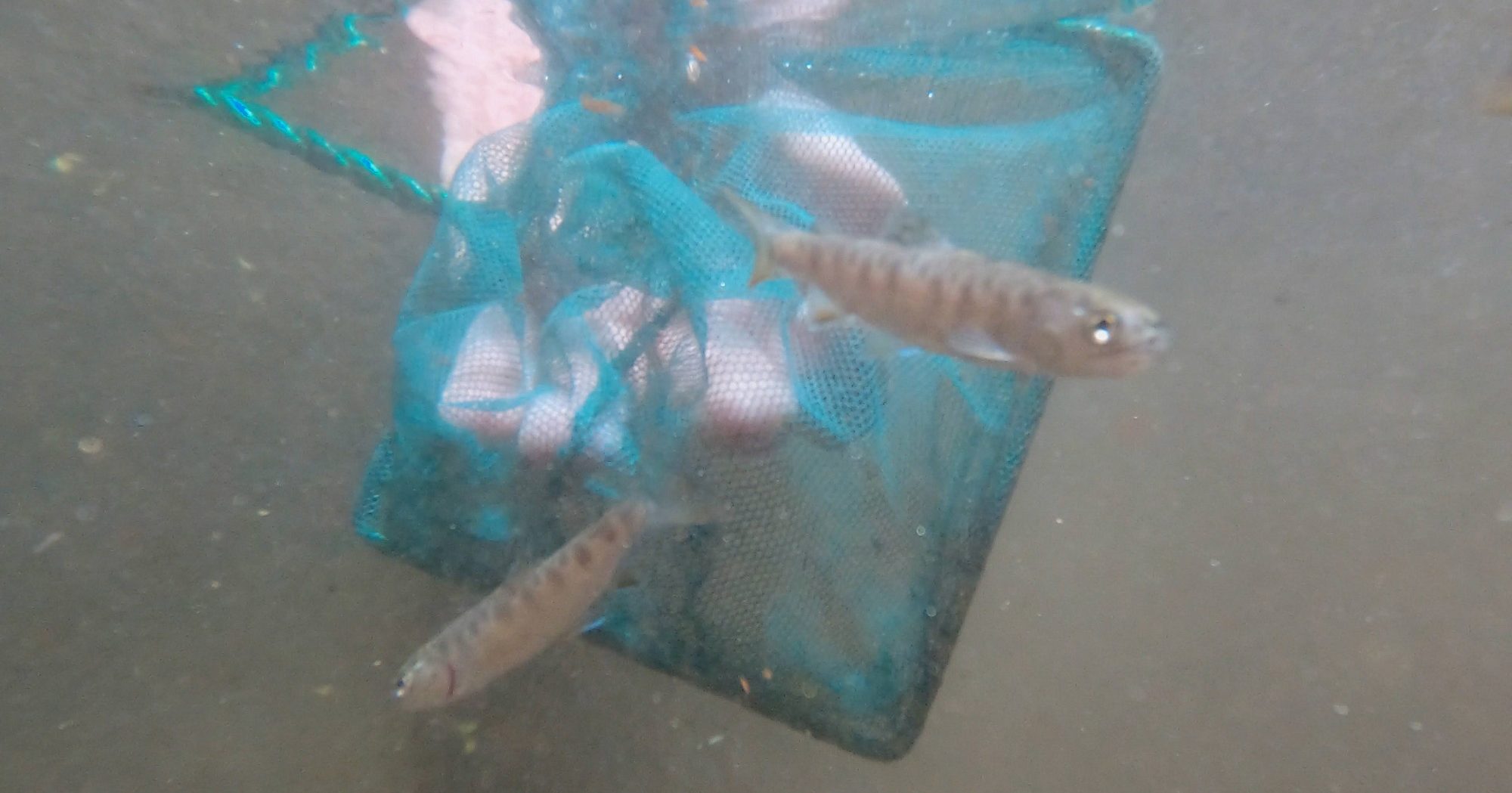Chattanooga, Tenn. (June 16, 2021) – Navigating through a thicket of branches while clambering across slick boulders in a rushing mountain stream is a difficult task at the best of times. Doing so while attempting to balance 40-pound buckets of water filled with imperiled fish takes the challenge to an entirely new level.
Recently, a team of scientists from the Tennessee Aquarium Conservation Institute drove to one of the lush, high-elevation streams in the southern reaches of the Cherokee National Forest. During a brief lull between summer rainstorms, they were joined by Tennessee Wildlife Resources Agency representatives and the U.S. Forest Service to celebrate a homecoming for 250 long-lost residents of this gorgeous landscape: juvenile Southern Appalachian Brook Trout.
Carefully navigating through a snarl of streamside vegetation, participants paused to release five or six trout at a time into pools with overhangs where the young fish could hide from predators and ambush floating insects that washed into the stream. The going was tough, but those involved in the effort to restock almost a kilometer of this pristine creek say the challenge was worth the reward of seeing Tennessee’s only native trout back in its ancestral waters.
“The days when we release fish, especially Brook Trout, are really special moments,” says Tennessee Aquarium Aquatic Conservation Biologist Dr. Bernie Kuhajda. “We’re with these fish all the way from when we first bring adults into the Conservation Institute to spawn, to watching the eggs start to develop, to the juveniles that are just a few inches long and ready to release here.
“It really is knowing that we get to help restore trout to the full circle of life. Days like today are the culmination of all that work to put trout back into the southeastern streams where they belong.”
Like many Appalachian streams, this tributary of the North River in the Tellico River watershed hasn’t hosted Southern Appalachian Brook Trout for almost a century. Clearcutting of forests in the early 1900s made waters in the region too warm. Combined with the introduction of Brown and Rainbow Trout, “Brookies” were effectively lost from more than 75 percent of the waterways where they once thrived.
Today, thanks to changes in forestry management, a thick canopy of leaves now shades streams that once were uncovered and sun-exposed. As a result, many creeks that had become too warm are now cool enough to be restocked with Brookies, who favor the colder temperatures.
TWRA began the effort to restore Brookies to their home in the 1980s. Since 2012, the Aquarium has contributed to this campaign by collecting and spawning adult broodstock, fertilizing the eggs, and raising the fry to a releasable size. After overwintering at the Aquarium’s freshwater science center, conservation biologists and partnering agencies join forces each spring to release the small juveniles into sites where natural or installed barriers such as waterfalls give them the best chance to thrive without competition.
After years of restocking populations in the northern region of the Cherokee National Forest, partners in this program have shifted their focus southward this year. Once experts found its waters to be healthy and free of competition from other trout, the stream selected this year was ready to receive its first class of Brookies. This release is the first for this location, which will continue to be restocked until the population in the stream is self-sustaining.
“When we move to a new location like this, it’s a sign that we’re progressing and have had some success in our effort to restore that habitat,” Kuhajda says. “This is sort of a feather in our cap to start a new population in a new drainage system where we haven’t worked before. It’s pretty exciting.”
As adults, the Southern Appalachian Brook Trout stands out for its bright orange belly, fins with stark white edging, and sides mottled by brilliant dots of gold and crimson. It’s a species whose beauty anglers describe with awe.
More importantly, however, Brookies are true-blue Southeasterners, the region’s only native troutspecies. That fact alone should inspire a desire to see them restored to their homes, says TWRA Regional Fisheries Program Manager Mark Thurman.
“The Southern Appalachian Brook Trout is definitely part of Tennessee’s heritage,” Thurman says. “The biodiversity in this state is incredible, and it’s important for people to recognize that.
“We’re putting a lot of work into keeping this fish out in the landscape.”
The Appalachian Chapter of Trout Unlimited funds the Aquarium’s participation in the restoration of Southern Appalachian Brook Trout through the sale of special Brook Trout-themed vanity license plates. Since 2013, Trout Unlimited grants have provided more than $68,000 to fuel the Aquarium’s propagation and release efforts.
In 1989, a sister waterway to the restocked stream was the focus of a restoration effort undertaken by Trout Unlimited, TWRA, the Forest Service, and the Tennessee Valley Authority. The broodstock whose offspring were released by the Aquarium this year were collected last fall from the nearby stream that was restored decades ago, a reminder that this type of conservation work happens because of long-term commitment from all partners and agencies.
“That’s great because here we see our work from way back when paying off,” says Steve Fry, Chairman of the Conservation Committee for the Tennessee Council of Trout Unlimited. “It’s good to see that the right strain of Southern Appalachian Brook Trout is going back in this stream again.
“We hope some other streams in that watershed will be able to receive Southern Appalachian BrookTrout in the future.”
